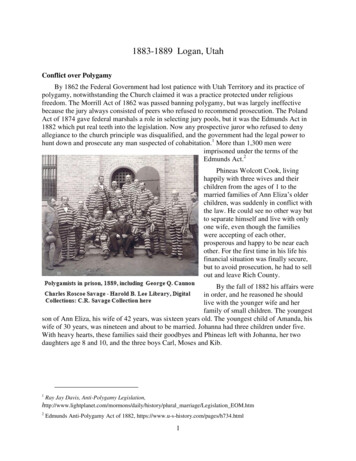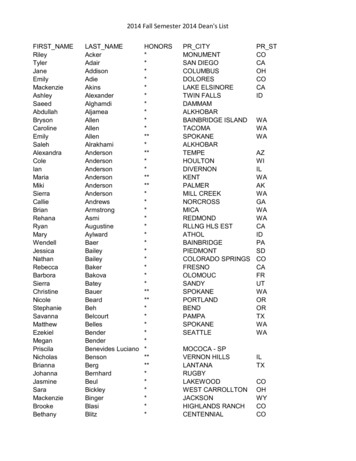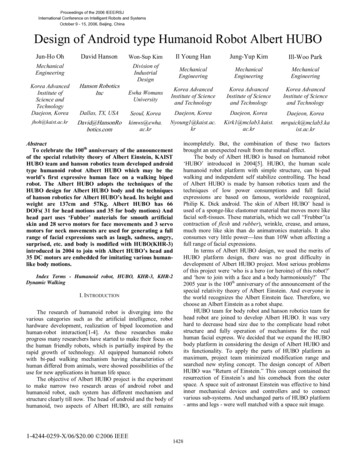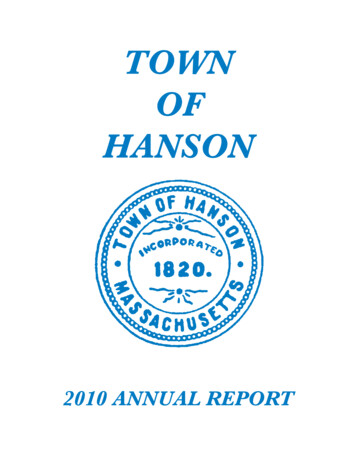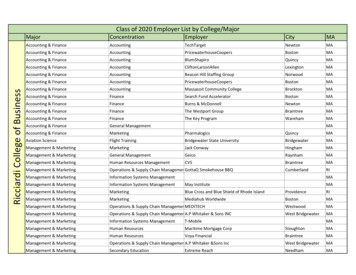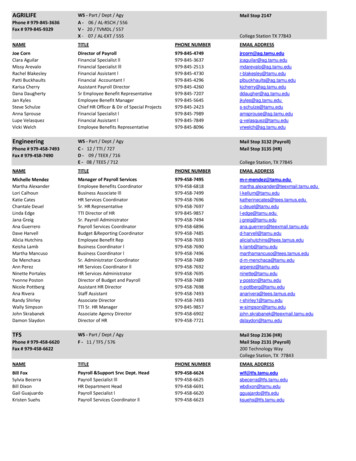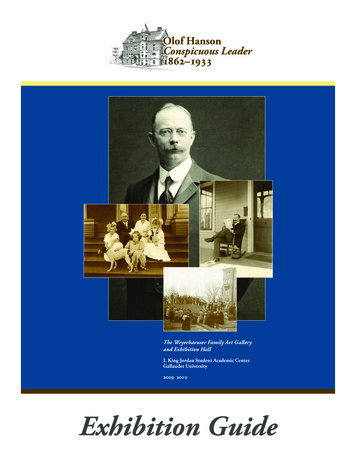
Transcription
Olof HansonConspicuous Leader1862–1933The Weyerhaeuser Family Art Galleryand Exhibition HallI. King Jordan Student Academic CenterGallaudet University2009–2010Exhibition Guide
Olof HansonConspicuous Leader1862–1933The exhibition is made possible partially through the generosity of the Class of 1958 andFriends of the Gallaudet University MuseumThe Gallaudet University Museum and the Olof Hanson, Conspicuous Leader, 1862-1933exhibition are sponsored by the Division of Academic AffairsPhotographs and documents, provided by the Gallaudet University ArchivesPhotograph of Juneau, Alaska Courthouse, provided by Michael Olson Private CollectionThe Weyerhaeuser Family Art Gallery and Exhibition HallI. King Jordan Academic CenterGallaudet University2009-20101
Olof HansonConspicuous Leader1862–1933Born in 1862 in Fjälkinge, Sweden, Olof Hanson immigrated in 1875withhis family to Willmar, Minnesota. Hanson lost his hearing gradually andbecame profoundly deaf at age of 13. At the age of 16, he became a stu dent at the Minnesota Institute for Deaf, Dumb, and Blind and graduatedthree years later.In the fall of 1881, Hanson enrolled at the National Deaf-Mute College,now known as Gallaudet University. He was involved with the College’sfirst football team, the debate team, and the bicycle squad. He graduatedin 1886 as class valedictorian with a liberal arts degree. After graduation, hiscompetitive spirit and passion led him to explore the field of architecture.With the help of Senator William Drew Washburn (father of Cadwallader),Hanson began his architectural career with Hodgson and Son architecturefirm. From his training, he received his Master of Arts degree from the Na tional Deaf-Mute College in 1889. Shortly thereafter, Hanson traveled for ten months throughout Europe,studying at L’Ecole des Beaux Arts for five months and visiting schools for deaf children.Hanson returned to Faribault after his travels and began teachingat the school for deaf children. Two years later, he set up his ownarchitecture firm. It is not clear how Hanson and Agatha Tiegel met. It is possible that they met at the National Deaf-MuteCollege or in Faribault, Minnesota where Agatha taught at theresidential school for deaf children. They were married in 1899in Pittsburgh, Pennsylvania. They had three hearing daughters,Alice, Marion, and Helen.In 1901, Hanson entered into a partnership with Frank Thayer, a hearing architect in Mankato, Minnesota.During their two-year collaboration, Hanson, with his family, moved to Seattle, Washington. In his lifetime,Hanson designed over 100 buildings, including buildings for schools, stores, hotels, a courthouse, churches,private residences and a Deaf Club.Including one of Hanson’s architectural accomplishments is a dormitory for boys at Kendall School at theNational Deaf-Mute College. Of Victorian character, the building is three stories tall, not including thebasement. An elaborate, four-story circular turret with a pointed roof dominates the southwest side of thebuilding. Two short but imposing chimneys crown the northeast side of the roof. In order to admit as muchnatural light as possible, the building has a total of 78 windows.2
Olof HansonConspicuous Leader1862–1933In the fall of 1911, College President Edward Miner Gallaudet and the Board of Trustees announced thatthe Kendall School dormitory for the boys would be named Dawes House in recognition of Senator HenryL. Dawes. Senator Dawes, a Republican from Massachusetts, was a member of the College’s Board of Trust ees from 1869 to 1903 and was an influential member of Congress who secured funds for new buildings forthe College.Shortly after college, Hanson was confirmed as an Episcopalian.His commitment to the church continued throughout his life. In1909, he set up a bible class for the deaf. Hanson was consecratedas a deacon in 1924 and five years later, he was ordained a priest.During Hanson’s time as a priest, he continued to work as a con sulting landscape architect and draftsman at the University of Wash ington until his death.In 1914, Gallaudet College, in recognition of his accomplishments,honored Olof Hanson with an honorary degree. The National Reg ister of Historic Places registered four of Hanson’s buildings after hisdeath.On September 7, 1933, Hanson was admitted to a hospital for ab dominal pains and died the next day. Hanson is buried at EvergreenMemorial Park in Seattle, Washington.Olof Hanson was a talentedarchitect, gifted wordsmith, leader, and a tireless advocate for deaf people.He worked within the context of his times, both influenced by and influ encing society’s perceptions on what it meant to be a deaf person.3
Olof HansonConspicuous Leader1862–1933Chronology of the Life and Times of Olof Hanson1862: Olof Hanson is born in Fjälkinge, Sweden1864: Abraham Lincoln, president of the United States, signs the charter for The National College for theDeaf and Dumb (now Gallaudet University).1865: The American Civil War ends; the name of National College for the Deaf and Dumb changes toNational Deaf-Mute College.1875: Hanson immigrates to Minnesota with his family.1878: Hanson enrolls at the Minnesota Institute for the Deaf, Dumb, and Blind in Faribault, Minnesota.1881: Hanson enrolls at the National Deaf-Mute College in Washington D.C.1886: Hanson graduates as class valedictorian from the National Deaf-Mute College.1888: Agatha Tiegel enrolls at the National Deaf-Mute College.1889: Hanson receives his master’s degree in architectural studies from the National Deaf-Mute College.1889-1890: Hanson spends ten months in Europe studying architectural styles and visiting schools for deafchildren.1893: Agatha Tiegel is the first woman to graduate from the National Deaf-Mute College.1894: The National Deaf-Mute College is renamed Gallaudet College in honor of the Reverend ThomasHopkins Gallaudet.1895: Construction of the Kendall Boys’ Dormitory (Dawes House) designed by Hanson,is completed.1899: Olof Hanson and Agatha Tiegel marry in Pittsburg, Pennsylvania. A few weeks later, they attend theNational association of the Deaf convention in St. Paul, Minnesota.1900: Olof and Agatha welcome their first daughter, Marion Fay.4
Olof HansonConspicuous Leader1862–19331901: Hanson enters into a partnership with fellow architect, Frank Thayer.1902: The Hanson family moves to Seattle, Washington.1904: Alice, the Hanson family’s second daugher is born.1906: Agatha gives birth to Helen, the last daughter of the Hanson family.1908: Hanson writes a letter to President Theodore Roosevelt, which helps the support of the rescinding ofthe Civil Service exam order.1910: Hanson is elected president of the National Association of the Deaf.1912: Hanson writes a letter to Mr. Carroll G. Pearse, President of the National Education Association,about using the combined method with deaf children. Hanson also wrote many letters to government andorganization leaders.1913: Hanson’s term as National Association of the Deaf president ends.1914: Hanson receives an honorary degree from Gallaudet College.1922: Hanson begins studying for ministry.1924: Hanson is consecrated as an Episcopalian deacon.1929: Hanson is ordained as an Episcopalian priest.1933: Hanson dies in Seattle, Washington.5
Olof HansonConspicuous Leader1862–1933History of Dawes HouseBy Willis Mann, ’67Dawes House, which sits between Kendall Hall and Fowler Hall, is the only building on the GallaudetUniversity campus designed by a deaf person. In his book on the “History of the College for the Deaf,”Edward Miner Gallaudet gives credit for the design of the Kendall Boys’ Dormitory (later named DawesHouse) to Olof Hanson of Faribault, Minnesota, a graduate of the National Deaf-Mute College, class of1886 (1) Dawes House sits within the National Historic District formed by Gallaudet’s early buildings.The building, which was completed in 1895, was named in honor of Henry L. Dawes, a U.S. Senator fromthe State of Massachusetts, who was a member of Gallaudet’s Board of Trustees from 1869 to 1903. SenatorDawes was instrumental in securing funds for several buildings on the Gallaudet campus, including DawesHouse. According to an updated paper written by alumnae Betty Williams, ’53, Dawes may have also usedhis considerable influence with members of the House of Representatives to get them to agree to providefunds for construction of these buildings. The decision to give the building the name Dawes House wasannounced by E. M. Gallaudet in a September 20, 1911 memorandum sent to the campus community inwhich he stated, “The Kendall School boys’ dormitory will be known as Dawes House.” (2)A building of decidedly Victorian character, Dawes House bespeaks the elegance of a bygone era whenextravagant style elements sometimes over-shadowed function. The building is three stories tall, not includ ing the basement, and was originally constructed to be a dormitory for the boys from Kendall School for theDeaf, which was in close proximity to Kendall School. It continued to serve this function until 1953 whenthe new facilities for the Kendall School, including dormitories, were built on the west side of the campuswhere the Kellogg Conference Center Hotel now stands. The dormitory for female students of KendallSchool was House 4 on Faculty Row.As was done with Kendall Hall, Dawes House is situated on a northeast to southwest axis. An elaborate,four-story circular turret with a pointed roof reminiscent of ancient castles dominates the southwest side ofDawes House. Two short but imposing chimneys crown the northeast side of the roof. In order to admit asmuch natural light as possible, the northeast side of the building has an array of 29 windows, 8 on the firstfloor, 7 on the second, and 4 on the third, with 4 more providing light for the central staircase. Even thebasement was designed to admit natural light and has 6 windows at ground level on the northeast side. Con tinuing this theme of access to natural light, Hanson incorporated 16 windows on the southeast side, 27 onthe southwest side facing College Hall, of which 6 are in the basement, and then 6 more on the northwestside, which receives no sunlight at all.Dawes House has served many different purposes since its use as a dormitory was discontinued in 1953. Thebuilding has been subdivided into offices, and over the years various departments of the University have hadoffice space in the building. The Department of Linguistics and Interpreting, the Office of Sponsored Pro grams, International Center on Deafness, the Tutorial Center, the College of Professional Studies, and severalother departments have all had offices in Dawes House at one time or another. And although the building is6
Olof HansonConspicuous Leader1862–1933in need of renovations throughout all these comings and goings Dawes House has remained a vivid link toGallaudet’s Victorian past.Sources:1.Edward Miner Gallaudet, “History of the College for the Deaf,” Gallaudet University Press, Washington,D.C., 1983; 1892.Memorandum from Edward Miner Gallaudet, September 20, 1911, Gallaudet University Archives.7
Olof HansonConspicuous Leader1862–1933BackstoryBy Christine Katsapis, Ph.D.Director of Office of Sponsored ProgramsThe Office of Sponsored Programs (OSP) of Gallaudet University primarily facilitates applications to thefederal government for grant funding. When the OSP was moved to historic Dawes House, the staff wasinspired. Dawes House is the only building standing on campus that was designed by a deaf individual,Olof Hanson. Alumni would visit the old dormitory rooms (with their original lockers) and share with theOSP staff stories of their family members who had lived in those rooms. The office even had a spiralstaircase that was for bringing sick students up to the nurses’ quarters. Those things combined with oldfireplaces and original wood trim made it easy to envision how it might have been as the boy’s dormitory.Intending to honor Olof Hanson, the OSP then set about learning about his career and developing a specialdisplay of his story, art, and building designs. Scans of his original works were purchased from the GU Ar chives and mounted along with a picture depicting the day that Dawes House cornerstone was set. The OSPdecided to donate the images to the Gallaudet University Museum to be expanded into an exhibit madeavailable to the public.8
Olof HansonConspicuous Leader1862–1933BibliographyThis bibliography provides resources on Olof Hanson’s life and the historical and social context of his time.For a detailed list of bibliography and endnotes, please contact museum@gallaudet.edu.BooksBerg, Otto. A Missionary Chronicle: Being a History of the Ministry to the Deaf.Maryland: St. Mary’s Press, Publishers: 1984.Buchanan, Robert. Illusions of Equality: Deaf Americans in School and Factory 1850-1950. Washington,D.C.: Gallaudet University Press, 1999.Burch, Susan. Signs of Resistance: American Deaf Cultural History, 1900-1942. New York: New YorkUniversity Press, 2002.Gannon, Jack. Deaf Hertiage: A Narrative History of Deaf America. Washington, D.C.: National Associationof the Deaf, 1981.Lang, Harry G. and Bonnie Meath-Lang. “Olof Hanson.” Deaf Persons in the Arts and Sciences: ABiographical Dictionary. Westport, Connecticut: Greenwood Press, 1995.Mannes, Judy. “Olof Hanson.” Gallaudet Encyclopedia of Deaf People and Deafness (2: 1-3). Ed. John V. VanCleve. New York: McGraw-Hill Book Company, 1987.PeriodicalsFroehlich, Theo A. “Importance of Association Among Mutes for Mutual Improvement.” First Proceedingsof National Association of the Deaf. New York: New York Institute for the Deaf and Dumb, 1880.Hanson, Olof. “An Open Letter.” The Silent Worker 24.9 (1912): 171.Hanson, Olof. “The Tendency Among the Deaf to Exclusive Association With One Another.” AmericanAnnals of the Deaf 3 (1888): 28-32.9
Olof HansonConspicuous Leader1862–1933Websites“Olof Hanson, Architect.” MinnDeafNews.com. itect.html.“Who Was Connected to Civic and School Buildings?: Olof Hanson.” People of the Past: Faribault HeritagePreservation Commission. 2002.http://www.faribault.org/History1/Civic people.htm.For more information about the Charles Thompson Memorial Hall, please visit Doug Bahl’s article found athttp://www.minndeafnews.com under the link, “Thompson Hall” or go directly 20Hall.html.For specific interest in U.S. Special Census on Deaf Family Marriages and Hearing Relatives, 1888-1895,please visit http://www.ancestry.com and search for “U.S. Special Census on Deaf Family Marriages andHearing Relatives, 1888-1895.” The database can be accessed for free at the Gallaudet University Archives.CollectionsAgatha Tiegel Hanson Collections, Manuscript 14. Processed by Carie Lyn Kelly. Gallaudet University Ar chives, Washington D.C., 1984.“Faculty Minutes,” vol. 2. National Deaf Mute College: 1887-1905. Gallaudet University Archives, Wash ington D.C.Olof Hanson Collections, Manuscript 15. Processed by Mike Olsen. Gallaudet University Archives, Washing ton D.C., 2006.Hanson, Olof. Letter to Caroll G. Pearse, President National Education Assocaition. 1912. Deaf RareBooks. Gallaudet University Archives, Washington D.C.Roosevelt, Theodore. Letter to Richard Hurd. January 3, 1919. Library of Congress.“Biographical Note.” Frank Thayer collection. Northwest Architectural Archives.10
Olof HansonConspicuous Leader1862–1933CreditsThe exhibit is made possible partially through the generosity ofthe Class of 1958 and Friendsof the Gallaudet University MuseumPhotographs and Documents, provided by the Gallaudet University ArchivesPhotograph of Juneau, Alaska Courthouse, provided by Michael Olson Private CollectionExhibition TeamExhibition CuratorTabitha JacquesExhibition DesignerScott CarolloExhibition ConsultantDrew RobargeExhibition EditorsJean Bergey, Outreach Program, CPSOBrian Greenwald, Associate Professor, Government and HistoryUlf Hedberg, Director of Deaf Library Collections and ArchivesExhibition Project DirectorJane NormanAcknowledgements:Christine C. A. Katsapis, Director, Office of Sponsored ProgramsDeaf Library Collections and ArchivesAllison Wickens, Director of Education, National Postal Museum, Smithsonian InstitutionDan Falk, National Postal Museum, Smithsonian InstitutionInstitutional Advancement, Development and Public RelationsDoug Bahl, ’74Mary K. Lott, Program Manager, Campus ActivitiesGallaudet University Physical Plant DepartmentKim Sexton, Administration SecretaryGallaudet University MuseumHonorary Co-ChairsJack R. and Rosalyn Lee Gannon, ’59CommitteeLloyd Ballinger, ’83Jean BergeyScott Carollo, ’95Daphne Cox, ’82Brian Greenwald, ’96, Vice-ChairKristen HarmonUlf HedbergCarolyn McCaskill, ’77, G-’05Joseph MurrayJane Norman, ’68 Chair and DirectorEdgar Palmer, ’78, G-’03Drew Robarge, ’0711
Gallaudet University MuseumMapping the Future, Guided by the PastMission StatementGallaudet University Museum promotes and interprets the rich and complex deaf experience.Vision StatementAs a premier research and informational resource center, the Gallaudet University Museum will:* Provide national leadership on public presentation of deaf history and contemporary life.* Collect and preserve material culture for scholarly research and for posterity in close collaboration withGallaudet University Archives.* Exhibit artifacts and ideas that inform, inspire, and challenge common understandings of deaf life fromcultural, linguistic and sensory perspectives.* Create public programming serving the campus, the neighborhood surrounding Gallaudet University,diverse Washington, D.C. constituencies, and local, national and international audiences.* Advance the educational mission of Gallaudet University by providing opportunities for shared researchand academic collaboration.museum@gallaudet.edu12
Gallaudet UniversityGallaudet University is the world leader in liberal education and career development for deaf and hardof hearing undergraduate students. The University enjoys an international reputation for the outstandinggraduate programs it provides deaf, hard of hearing, and hearing students, as well as for the quality of theresearch it conducts on the history, language, culture, and other topics related to deaf people. In addition,the University’s Laurent Clerc National Deaf Education Center serves deaf and hard of hearing children atits two demonstration schools and throughout the nation by developing, implementing, and disseminatinginnovative educational strategies.Gallaudet University MuseumMapping the Future, Guided by the PastGallaudet University800 Florida Avenue, N.E.Washington, D.C. 20002
dent at the Minnesota Institute for Deaf, Dumb, and Blind and graduated three years later. In the fall of 1881, Hanson enrolled at the National Deaf-Mute College, now known as Gallaudet University. He was involved with the College's irst football team, the debate team, and the bicycle squad. He graduated
